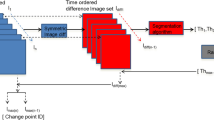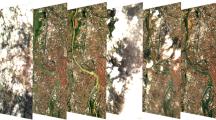Abstract
The framework of mining of moving objects from image data sequence is presented. Scenes are first clustered and labeled by using two-stage SOM that is modified to recognize images including similar moving objects as the same cluster, and that well recognizes scenes including prominent objects. After extraction of images which include prominent objects based on clustering result, the position and the shape of objects are approximated by using mixture gaussian model via EM algorithm, providing the adequate or larger number of components. By adopting the average of the data points in the smaller blocks as the initial parameters, the solutions are stabilized and the identification of components among time-series images and the tracking of a specific object become easier.
This framework is applied to a four-year (ranging from 1997 to 2000) dataset of cloud images taken by Japanese weather satellite GMS-5 to evaluate its performance. Modified SOM method well classifies scenes which include prominent moving object, and seasonal variation tendency is detected in the cluster ID sequence. The result of object detection via EM algorithm for summer-type images including clear cloud masses such as typhoons shows that this approach well approximate the adequate distribution of cloud masses in many cases. Objects in the very irregular shapes are also well represented as the mixtures of gaussians.
The extracted object information, together with the scene clustering result, is expected to offer us a rich source for knowledge discovery of video datasets. This approach is one of the effective ways of mining video images whose characteristics are unknown in advance, and thus applicable to the various type of applications.
Similar content being viewed by others
References
Burl, M.C., Asker, L., Smyth, P., Fayyad, U.M., Perona, P., Crumpler, L., and Aubele, J. (1998). Learning to Recognize Volcanoes on Venus. Machine Learning, 30(2/3), 165–195.
Fayyad, U.M., Djorgovski, S.G., and Weir, N. (1996). Automatic the Analysis and Cataloging of Sky Surveys. Advances in Knowledge Discovery and Data Mining (pp. 471–493). AAAI Press/MIT Press.
Gaffney, S. and Smyth, P. (2001). Clustering of Extra-Tropical Cyclone Trajectories Using Mixtures of Regression. In Proceedings of Fourth Workshop on Mining Scientific Datasets in Conjunction with 7th ACM SIGKDD International Conference on Knowledge Discovery and Data Mining, Aug. 2001.
Hand, D., Mannila, H., and Smyth, P. (2001). Principles of Data Mining. Cambridge, MA: The MIT Press.
Honda, R., Iijima, Y., and Konishi, O. (2002). Mining of Topographic Feature from Heterogeneous Imagery and its Application to Lunar Craters Newblocks. In Progresses in Discovery Science, Lecture Notes in Computer Science (pp. 395–407). Berlin: Springer-Verlag.
Honda, R. and Konishi, O. (2001). Temporal Rule Discovery for Time-Series Satellite Images and Integration with RDB. In Principles of Data Mining and Knowledge Discovery: Fourth European Symposium (pp. 204–215), Sept. 2001.
Katayama, K. and Konishi, O. (1999). Construction Satellite Image Databases for Supporting Knowledge Discovery ( in Japanese). Transaction of Information Processing Society of Japan, 40(SIG5(TOD2)), 69–78.
Kohonen, T. (1997). Self-Organizing Maps. 2nd edn. Berlin: Springer.
Nagao, H., Higuchi, T., Iyemori, T., and Araki, T. (2002). Automatic Detection of Geomagnetic Jerks by Applying a Statistical Time Series Model to Geomagnetic Monthly Means. In Progresses in Discovery Science, Lecture Notes in Computer Science (pp. 360–371). Berlin: Springer-Verlag.
Schwarz, G. (1978). Estimating the Dimension of a Model. Annals of Statistics, 6, 461–464.
Smyth, P., Burl, M.C., and Fayyad, U.M. (1996). Modeling Subjective Uncertainty in Image Annotation. In Advances in Knowledge Discovery and Data Mining (pp. 517–539). AAAI Press/MIT Press.
Smyth, P., Ghil, M., and Ide, K. (1998). Multiple Regimes in Northern Hemisphere Height Fields via Mixture Model Clustering. Journal of the Atmospheric Sciences, 56(21), 3704–3723.
Author information
Authors and Affiliations
Rights and permissions
About this article
Cite this article
Honda, R., Wang, S., Kikuchi, T. et al. Mining of Moving Objects from Time-Series Images and its Application to Satellite Weather Imagery. Journal of Intelligent Information Systems 19, 79–93 (2002). https://doi.org/10.1023/A:1015516504614
Issue Date:
DOI: https://doi.org/10.1023/A:1015516504614




